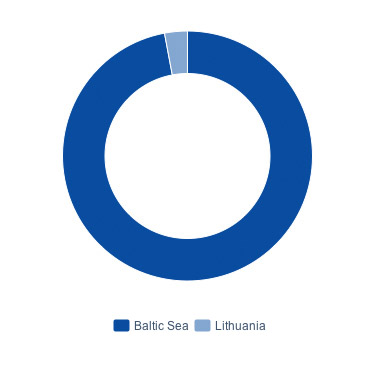- Home /
- Achievements and forecasts /
- Exploration and production /
- Achievements
- LOTOS Annual Report 2011 /
- Home /
- Achievements and forecasts /
- Exploration and production /
- Achievements
Achievements
In 2011, the acquisition of full control over the Lithuanian production company AB Geonafta was finalised.
Major achievements in the hydrocarbon exploration and production business in 2011 included:
Poland:
- continued production from the B3 field,
- work aimed at developing the B8 field, including positive results obtained from the B8-Z5 injection well, which confirmed parameters of the assumed development concept,
- work, in partnership with other companies, on developing the gas fields (the B4 and B6 fields and the B21 prospect) in the Gaz Północ and Gaz Południe license areas,
- building competence in the shale gas exploration in Poland,
- submitting two license applications, concerning Słupsk W and Słupsk E license areas,
- performing a restructuring of the maritime transport area.
Lithuania:
- closing of the transaction of acquisition of control over the Lithuanian assets - the interest in AB LOTOS Geonafta increased from 40.59% to 100%,
- five production wells were drilled in by companies of the AB LOTOS Geonafta Group.
Norway – Norwegian Continental Shelf:
- LOTOS E&P Norge's continued participation in development of the YME field,
- acquisition of seismic data for the PL 503 license, where LOTOS E&P Norge is the operator,
- award of a 25% interest in the PL 503B license in January 2011,
- licenses PL 497/PL 497B and PL 498 – preparations for drilling of exploration wells,
- license PL 556: based on the estimates of potential reserves and assessment of the risk with respect to drilling a well in the Snowlion prospect, the operator, acting in agreement with its partners, made a decision not to recommend entry into the second stage of exploration (drilling of a well) – an application was made to abandon the license,
- license PL 455: based on the findings made by the license partners, a decision was made to submit a letter to the Ministry of Petroleum and Energy requesting a change of duration (prolongation) of stage I of the exploration work by 12 months, i.e. until information is available from the Gafdorfa well, planned to be drilled in 2011 in a neighbouring license area (PL 406). The ministry accepted the application for extension by 12 months of the time to make a decision whether to drill a well or abandon the license, and it also changed the structure of the license interests (Skeie 55%, LOTOS E&P Norge 45%), awarding operatorship of the license to LOTOS E&P Norge,
- continuation of exploration projects – following submission of license applications in 2011, two new licenses were awarded in January 2012, in which LOTOS E&P Norge holds an interest (PL 643 – LOTOS E&P Norge 30%; PL 655 – LOTOS E&P Norge 30%).
In 2011, crude oil output totalled 227.1 thousand tonnes, of which:
- 78.1 thousand tonnes were produced in Lithuania,
- 149 thousand tonnes were produced in Poland.
As at December 31st 2011, crude oil reserves and resources held by the LOTOS Petrobaltic Group classified as 2P - amounted to 6.9 million tonnes (53.5m bbl) and those classified as 2C - 1.4 million tonnes (10.8m bbl), whereas its natural gas reserves and resources were 0.5 billion cubic metres (classified as 2P) and 6.4 billion cubic metres (classified as 2C).
In 2011, the situation of the LOTOS Group and the entire hydrocarbon exploration and production sector was determined mostly by the level of crude oil prices on global markets and the situation on the currency market. As a result of the crisis on the global financial markets, capital was withdrawn from stock exchanges and invested in non-financial assets, such as commodities, driving upwards the prices of crude. High prices of crude oil translated directly into higher revenues generated by LOTOS Petrobaltic. The economic slowdown and uncertainty as to whether eurozone countries such as Greece, Italy or Spain will be able to repay their debt, resulted in a significant depreciation of the developing countries' currencies, including the Polish currency. The uncertainty in the region also affects the perception of risk inherent in the upstream business development projects and an assessment of attractiveness of such projects by financing institutions.












